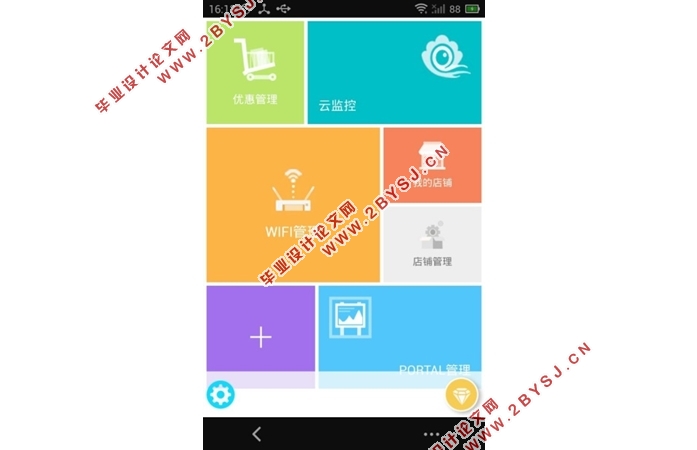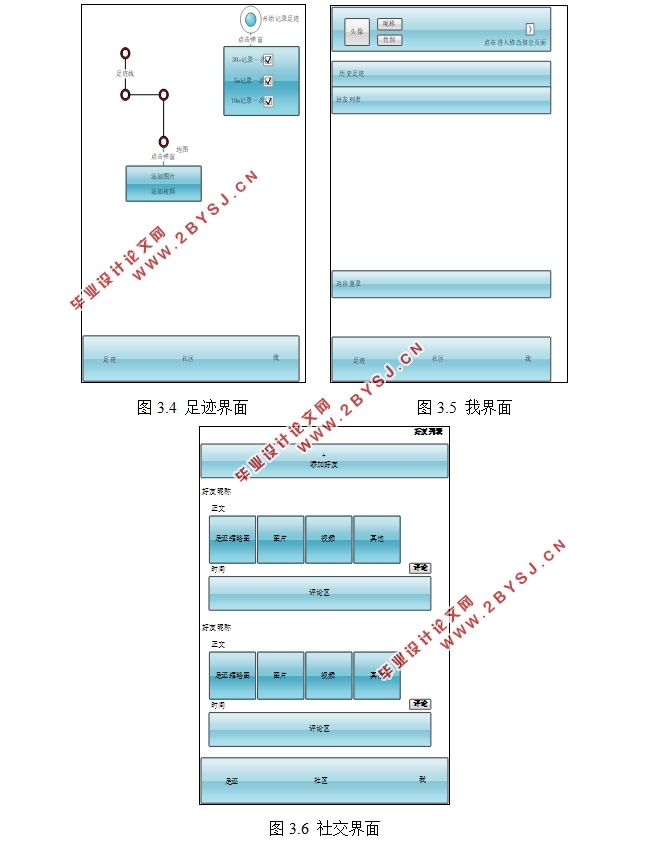基于安卓Android的定制广告推送系统商户端App的设计
无需注册登录,支付后按照提示操作即可获取该资料.
基于安卓Android的定制广告推送系统商户端App的设计(任务书,开题报告,论文11000字,程序代码)
摘 要
当今时代,传统网络广告投放方式广泛而非针对性的弊端日益突出,使得市场急需一个精准的网络广告推送系统。在此背景下,诞生了一个新的广告模式——大数据环境下的精准广告系统,即通过大数据技术将广告目标精准定向到用户。凭借定向广告强大的市场需求以及其自身的优势,可以精准推送广告的系统必将带来极大的发展机遇。
论文是本人参与开发基于Android的定制广告推送系统项目的总结。该系统的实现,解决了商场商户对顾客进行定向广告推送的难题,既可以使顾客免费连接WIFI上网,又能使商户展示店铺给用户。本人工作如下:
1、学习了安卓开发的相关技术与理论对,对基于Android的定制广告推送系统进行了描述。
2、对系统的Android商户端部分进行需求分析和总体设计,描述了系统的实现过程。该系统是为店铺商量身定制的操作平台,商户使用者可以通过它实现如下功能:实时查看自己店铺的客流状况;对商场用户进行定向广告推送;设置自己店铺信息;设置编辑推送广告信息;APP用户设置等。
3、对完成后的系统进行软件测试,查找并改进使用时遇到的问题。对系统的整体开发过程进行了总结,并对系统的未来方向做了展望。
关键字:定制广告推送;Android;商户端
Abstract
In today's era, the traditional network advertising on a wide range of non targeted drawbacks are increasingly prominent, making the market is in urgent need of a precise network advertising push system. In this context, the birth of a new advertising model - the big data environment of the precise advertising system, that is, through the big data technology will be targeted to the user. With the strong market demand for directional advertising and its own advantages, the system can accurately push advertising will bring great opportunities for development.
This thesis is a summary of the project of developing customized advertising push system based on Android. The implementation of the system, to solve the problem of shopping mall merchants to push the customer targeted advertising, both to enable customers to connect WIFI Internet access, but also allows businesses to show the shop to the user. I work as follows:
1, learning the relevant technology and theory of the development of Android, based on the Android customized advertising push system is described.
2, the system of the Android business side of the demand analysis and the overall design, describes the implementation process of the system. The system is for shops to discuss customized operating platform, business users can through which to achieve the following functions: real-time view their shops in the traffic situation; to store user for targeted advertising push; set up their own store information; set the edit push send advertising information; app with user settings.
3, after the completion of the system for software testing, to find and improve the use of the problems encountered. The overall development process of the system is summarized, and the future direction of the system is prospected.
Key words: custom advertising push;Android;business Application
论文的内容和组织
本文主要内容是设计并实现基于Android的定制广告推送系统。首先介绍了本项目的研究背景以及研究意义,分析了国内外的发展现状,介绍了系统的整体架构,所需知识和相关技术,然后概述了通过软件开发生命周期的方法,完成整体布局框架和具体开发过程。最后,对本次系统设计与实现进行了总结和对未来的展望。本文的结构将按照如下方式组织:
第1章 绪论。介绍了基于Android的定制广告推送系统的研究背景、意义以及目前国内外的研究现状。并且提出了本文研究的主要内容。
第2章 相关技术综述。 主要介绍了在完成基于Android的定制广告推送系统的过程中所使用的理论与技术。
第3章 需求分析及总体设计。针对项目系统进行了充分的需求分析明确了为了实现其功能,系统应该做些什么。并且对该系统进行了概要设计,给出相应的系统用例图和Android端功能结构图。
第4章 详细设计。对系统按不同模块的开发过程进行详细描述。
第5章 测试。主要对该系统进行了界面和功能测试,并且给出了测试结果。
第6章 总结与展望。对全文的工作进行总结与展望,描述完成的工作和获得的收获,同时对未来做出展望,提出改进。
开发语言 Sun JAVA JDK6.0(或更高版本)
开发工具 Android Studio 或Eclipse+ADT
WEB应用服务器 Apache Tomcat 6.0.29(或更高版本)
开发环境的操作系统 Windows
客户端 安卓3.0以上



目 录
第1章 绪论 ……………………………………………………………………………1
1.1 项目背景 …………………………………………………………………………1
1.2 开发的目的及意义 …………………………………………………………........1
1.3 国内外研究现状....................................................................................................2
1.4 论文的内容和组织................................................................................................2
第2章 系统相关技术综述............................................................................................3
2.1Android简介...........................................................................................................3
2.2 ADT和SDK简介.................................................................................................3
2.3 Android Studio简介...............................................................................................3
2.4安卓系统架构.........................................................................................................4
2.5 Android四大组件...................................................................................................5
第3章 需求分析及总体设计.........................................................................................8
3.1需求分析..................................................................................................................8
3.1.1功能需求...........................................................................................................8
3.1.2性能需求...........................................................................................................9
3.1.3可行性分析.......................................................................................................9
3.1.4开发环境.........................................................................................................10
3.2总体设计................................................................................................................10
3.2.1商户端系统总体架构.....................................................................................10
3.2.2商户端系统功能模块介绍.............................................................................11
第4章 详细设计及实现...............................................................................................15
4.1 UI界面功能实现...................................................................................................15
4.2存储功能实现........................................................................................................16
4.3登录功能实现........................................................................................................16
4.4 WIFI管理实现......................................................................................................17
4.5云监控实现............................................................................................................18
4.6店铺管理实现........................................................................................................19
4.7 PORTAL管理实现................................................................................................20
4.8 APP设置功能实现...............................................................................................21
第5章 系统测试...........................................................................................................23
5.1软件测试定义和目的............................................................................................23
5.2软件测试的方法....................................................................................................23
5.3 系统测试...............................................................................................................23
5.4测试报告................................................................................................................30
第6章 总结与展望.......................................................................................................31
6.1 总结........................................................................................................................31
6.2展望.........................................................................................................................31
参考文献.........................................................................................................................32
致谢.................................................................................................................................33
